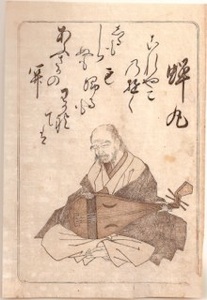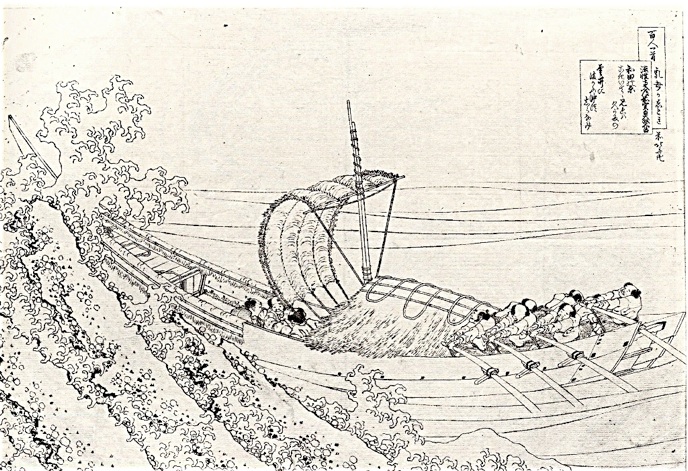法性寺入道関白太政大臣


わたの原
漕ぎ出でて見れば
久方の
雲ゐにまがふ
沖つ白波
ほっしょうじにゅうどうさきの
かんぱくだいじょうだいじん
わたのはら
こぎいでてみれば
ひさかたの
くもいにまがう
おきつしらなみ
Fujiwara no Tadamichi
As over the wide sea
I row out and look ahead,
The clouds in heaven
Can be mistaken for the
High-rising white-crested waves.
Hokusai
Fujiwara no Tadamichi (1097 - 1164), was the eldest son of the Japanese regent (kanpaku - who is a regent to an adult emperor) Fujiwara no Tadazane, and very young became regent himself. He was the father of Jien (poem 95) and grandfather of Yoshitsune (poem 91). As a monk in later years his name was Enkan. He was also a famous calligrapher with a penchant for kanji. The collection of his Chinese poems is called the Hosshoji Kanpaku Shu, and his Japanese poetry is called the Tadamichi Shu.
Tadamichi was involved in a power struggle that is known as the Hogen Incident (1156), which is related in the Hogen Monogatari. His side won. This heralded the beginning of a new era in Japan, the Kamakura period, which marks the transition to the Japanese medieval era, a nearly 700-year period in which the emperor, the court, and the traditional central government were left intact but were largely relegated to ceremonial functions. Civil, military, and judicial matters were controlled by the bushi class, or samurai, the most powerful of whom was the de facto national ruler. The term feudalism is generally used to describe this period.
See poem 75 for the exchange of poems between him and Mototoshi.
He retired to the Hosshoji temple (founded in 924 by Fujiwara Tadahira, poem 26), where he was head priest.
The interpretation of this poem rests mostly on the perception of waves and clouds. The experience of looking towards distant mountains and being confused about whether they are clouds or snowy peaks, is something many will recognize. But in this case the waves could stand for the turbulence of the times, and the clouds for heaven, meaning the government or imperial court. As regent Tadamichi was practically the most powerful person in Japan.
Kumoi has these meanings: sky, clouds, distant place, high place, imperial court. So a personal view of his important task (the poem was written in 1135, and he had become regent in 1123 and later again in 1141) could explain this poem. Did he foresee trouble ahead for the imperial court? Did he have secret ambitions (reading hisakata as hisashi kata, ‘lasting too long’)? Was the high task of regent more turbulent than the imperturbability of the imperial court?
Hokusai shows us the struggle of a rowboat in a turbulent sea with high-rising waves, so typical for his style. A strong wind is blowing and it seems that the rowers are pulling the boat against the direction of the wind, or trying to prevent the boat hitting the rocks, which means this is a struggle of man against nature, both pushing in different directions. The wind in the sail is pushing the boat forward. Three passengers seem unmoved. It is possible that Hokusai referred to political strife, the boat of government.



